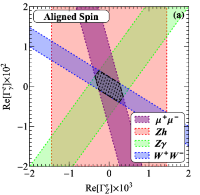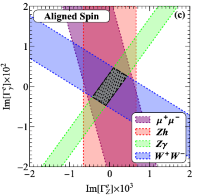Researchers Propose New Method for Studying Electroweak Dipole Interactions
Prof. YAN’s research group suggested using lepton colliders at China’s proposed Circular Electron Positron Collider (CEPC), Japan’s proposed International Linear Collider (ILC), and CERN’s proposed Future Circular Collider for electron-positron collisions (FCC-ee) to conduct the experiment.
Charged leptons, due to their spin effects, can be viewed as small magnets, resulting in interactions similar to those between magnets (i.e., magnetic dipole interactions). This interaction can be experimentally measured with extremely high precision and is widely used to search for NP effects beyond the Standard Model (SM). For example, the measurement of the muon anomalous magnetic moment at the Fermi Laboratory in the United States, which deviates by 5σ from the SM prediction, suggests the possible existence of electromagnetic dipole interactions induced by NP.
In line with the electroweak gauge theory, electromagnetic and weak interactions are unified. Therefore, if measurement results of the muon anomalous magnetic moment are induced by NP effects, we would expect weak dipole interactions induced by the same NP mechanism, with physical effects similar to the electromagnetic dipole interactions of leptons. In addition, dipole interactions are closely related to the spin of particles. For this reason, the physical effects induced by such dipole interactions would be “smeared out.” This would make it difficult for collider experiments focused on traditional non-polarized physical observables to discover them, thus resulting in weak constraints and heavy dependence on other potential NP effects in theoretical analysis.
According to the researchers, using transversely polarized positron and electron beams would effectively amplify the effects of dipole interactions related to spin direction and greatly improve the experimental detection capabilities of relevant NP mechanisms. Their research showed that, with this method, constraints on dipole interactions related to the Z boson are two orders of magnitude higher than results of traditional non-polarized methods from experiments at the Large Hadron Collider (LHC) and the Large Electron-Positron Collider (LEP). They are even two orders of magnitude higher than results of low-energy electron anomalous magnetic moment measurements.
This work also offers a new method for studying CP-violating effects. The measurements of CP-violating parameters are independent of NP assumptions related to CP-conserved interactions, laying an important theoretical foundation for the next step in using quantum chromodynamics spin physics research methods to explore NP effects.
The authors of this paper (in alphabetical order) are: Ph.D. student WEN Xinkai from Peking University, Professor YAN Bin from the Institute of High Energy Physics (corresponding author), former Ph.D. student YU Zhite from Michigan State University (now a postdoctoral researcher at Jlab), and Professor YUAN C.-P. from Michigan State University. This research was supported by the National Natural Science Foundation of China, the Start-Up Fund of the Institute of High Energy Physics, and the National Science Foundation of the United States.



Figures: (left) Schematic diagram of transverse polarization physical effects; (middle) constraints on the real part of the electroweak dipole interaction due to transverse polarization single-spin asymmetry; and (right) constraints on the imaginary part.
Paper link: https://journals.aps.org/prl/pdf/10.1103/PhysRevLett.131.241801
Contact Information
Ms. JIA Yinghua
jiayh@ihep.ac.cn